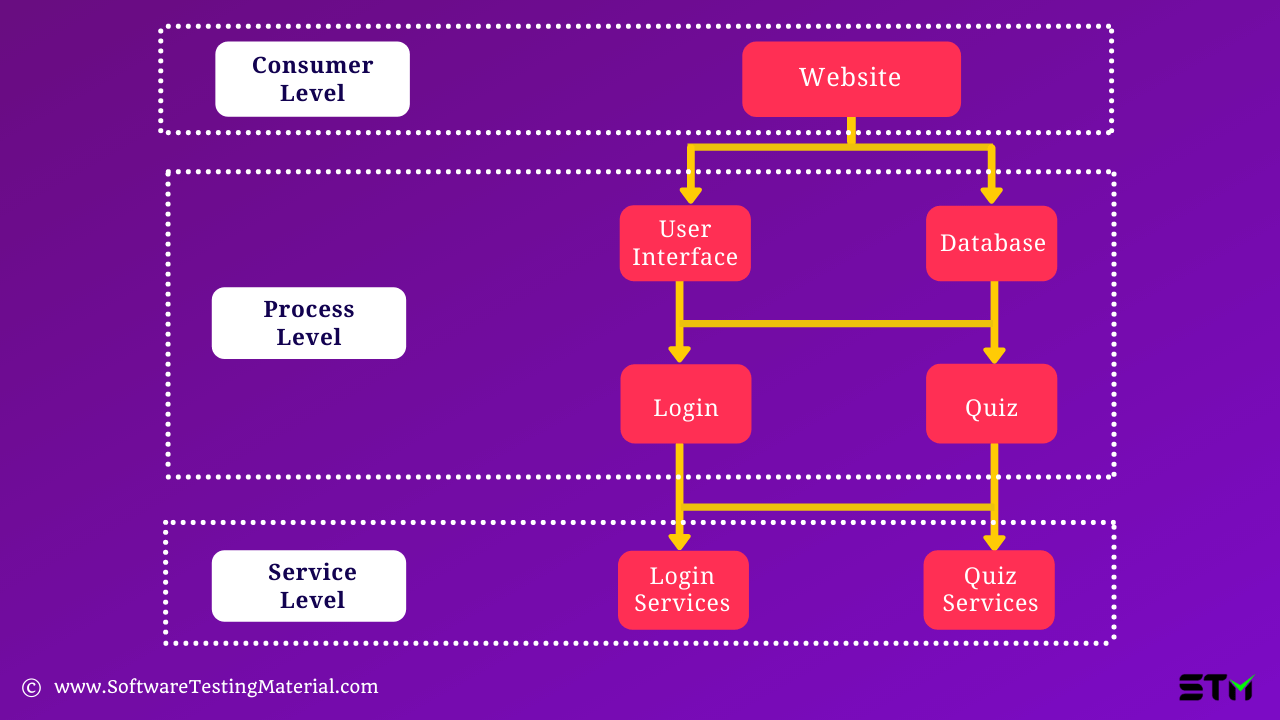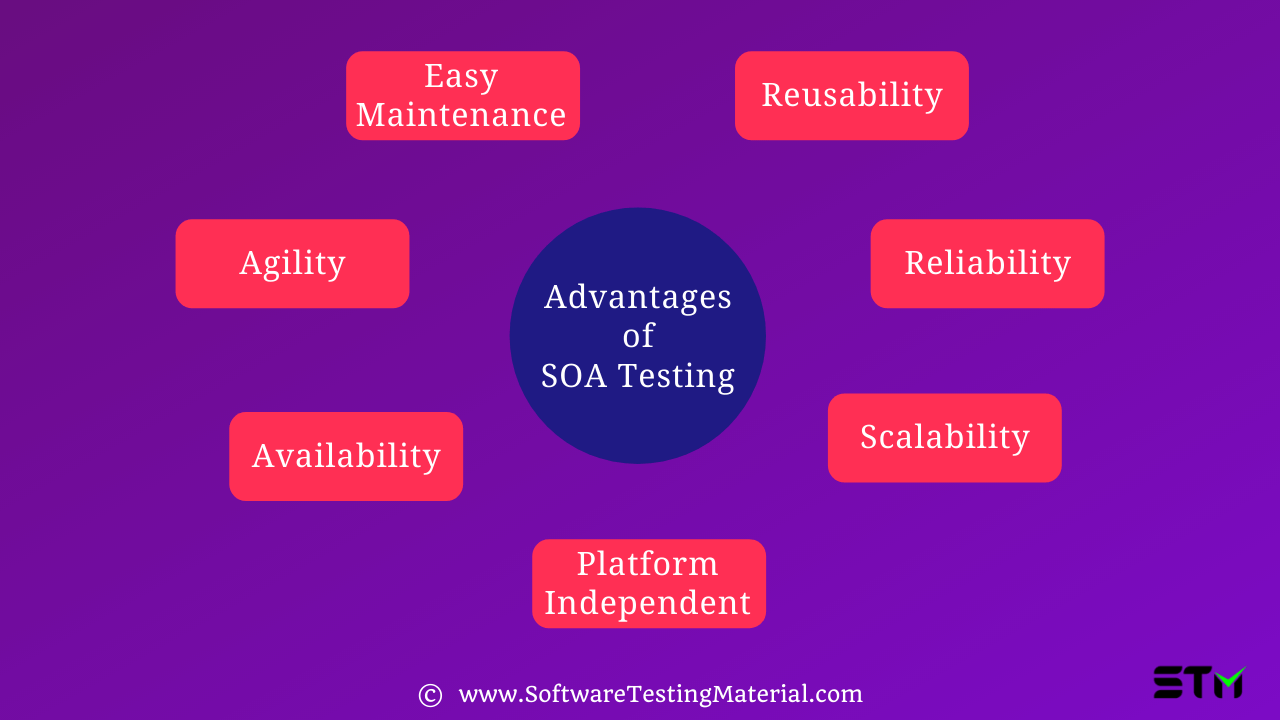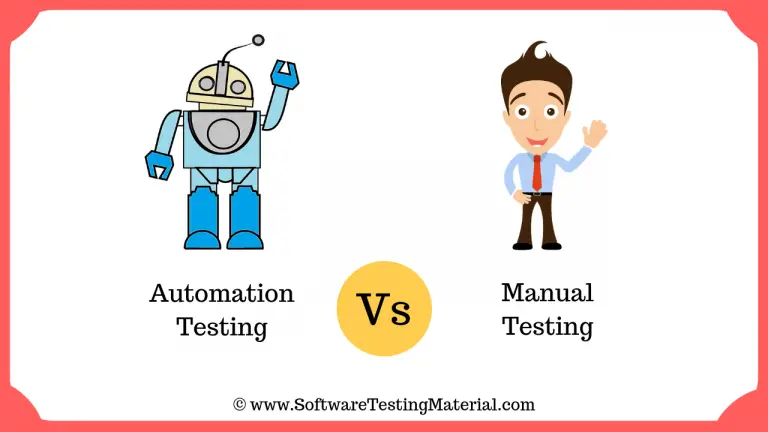SOA Testing | A Comprehensive Guide

In this SOA Testing tutorial, we will learn what is SOA Testing, the process of SOA Testing, and the following concepts in detail.
What is SOA
Service-Oriented Architecture is an architecture method using which business services split responsibilities into various services that are dependent on each other.
SOA is an architectural pattern that allows services to communicate with each other across different platforms and languages. It uses communication protocols for providing services to other components through application components.
SOA is loosely coupled, which makes plugin new service or upgrade existing service smooth. These interfaces use common communication standard which helps the organization to integrate with the different application without much effort while still having their application independent
SOA helps the organization by reducing the cost on infrastructure by accessing different services using network calls without performing deep integration each time. It makes software components to interact with various networks to work with each other. SOA is usually associated with XML and SOAP but understands that SOA is more than just a protocol.
Examples of SOA
SOA is being used in almost every sector and industry that is on the internet like healthcare, government, military, airforce, e-commerce, banks, food industry, etc,.
Few examples:
- SOA helped First citizen bank to offer services to its customers along with 20 other institutions using services like check imaging, check processing and outsourced customer service.
- OfficeMax using the services provided through SOA made core business functions like order fulfilment, real-time analysis of business transactions, track and measure product affinity, best-selling products, proactive inventory response, price error checks etc.
- Cisco exposed its ordering process and services using SOA to make sure its product ordering experience was consistent across all products and channels, divisions, acquisitions, and business partners.
What is SOA Testing
SOA testing is an important aspect of service life cycle management as it helps the organization to address multiple aspects of service quality across multiple SOA service implementations.
SOA testing is complex because a composite application has a lot of moving parts and interconnections, making it challenging to test. SOA testing validates the entire multi-layered architecture of a given software service. SOA testing tests a collection of legacy applications, custom-developed components or third-party components.
SOA testing is about verifying the web services that act as an interface between the client and the server.
Let’s take an example of a user checking the stock market, they provide details of their stocks to the system and the server fetches those details back to the user. The necessary SOA’s web service will communicate to the backend application or database, which will process the request and respond with a valid response.
SOA protocols facilitate the interaction between the client and the service provider, the entire architecture of SOA is based on these interactions.
SOA Web Services Architecture
Web services can be defined as services that are accessible over the web. It is a component that gets deployed in the server so it can communicate with other services through the internet.
- A web service gets published on the web by a service provider in the web service registry.
- The internet acts as a bridge between an application and web service.

Let’s looks at a simple example to explain how the consumer interacts with the web services
- User opens an application and searches for the data.
- Client system sends a request along with the URL to search for the service in the web service registry.
- Web service registry fetches a relevant response, the client gets URL and WSDL as a response.
- Communication gets established with the help of SOAP protocol by sending a response back to the service provider and requester.
- The received response gets converted to an HTTPS response which is the final response, the consumer’s application takes care of the decryption of the response.
SOA testing involves verification, validation, and authentication of service providers. Test engineers should be aware of all the SOA components.
SOA testing focuses on three system layers such as Consumer Level, Process Level, and Service Level.

Consumer Level
Consumer-level is the user interface level of the system. In testing terms, it’s the BlackBox area.
It contains the complete structure/hierarchy of interfaces i.e, the way the user interacts with the website, which sends the request to the back-end and returns the results to the user.
Process Level
Process level shows us how a business process gets implemented and integrated.
It includes a set of different services which are part of a single functionality.
Let’s say, a process here can be a part of the user interface and database etc.
Process level concentrates mainly on the interfaces and integration with database i.e the process.
We can understand the process layer using an example of an e-learning website.
The user takes a quiz on the website, the activities that happen in process level could be – adding new data, editing, deleting or creating new data.
Service Level
Service level contains several functionalities in which the application is built upon.
Here we can understand the concept of a service layer with the help of an e-learning website.
Usually, these websites have – Informational articles( blog), Videos ( youtube videos), email subscriptions for further updates.
These functions are primarily the ones that perform business functionalities.
Web services take care of the request/response transactions.
The website displays the respective data that the user requests. Services layer consists of the services which get the respective data from the Database–
- Blog service
- Video streaming service
- Email subscription service
SOA Testing Process
SOA follows the usual software testing life cycle each phase has its entry criteria and deliverables. But test engineers have to put more effort into configuring the required test environment as SOA is complex.
Each organization has its process to test the system, a general method used by most businesses is as follows.
- Requirements/design review
- Test planning
- Test designing
- Test environment setup
- Test execution
- Test reporting
Web Services Testing
Web service testing uses testing tools to verify the response from the server when a request gets sent.
Test data can be varying requests sent to the server in different scenarios.
As the application interacts with different web services through different API gateway, web services testing is important.
API testing tools such as Soap UI helps in performing the testing.
Check out our detailed API Testing Guide
Functionality Testing
Functionality testing in SOA can be testing the functionality of each service independently.
Usually, functional testing gets grouped with web service testing as both have similar processes.
Let’s take an example of a login service, it validates the provided credentials by receiving it from the consumer and sends it to the server. Here verification of both the functionality and the interaction between web services happen.
Check out our detailed Functional Testing Guide
Performance Testing
Performance testing in SOA can be the efficiency of service to deliver the expected response/communication in an optimum manner, with the least possible time frame.
It is usually done when the functionality of the services is completely validated.ve on to testing the performance of the services.
Performance testing uses performance testing tools like Jmeter, Gatling, etc.
Check out our detailed Performance Testing Guide
Security Testing
Security testing is quite crucial in SOA, as it communicates with several web services on the internet, the authenticity of the third-party service can be a concern.
Security testing deals with assessing and handling vulnerabilities such as SQL injection, cross-site scripting, etc.
Thus the testing team has to focus a lot on authentication and good security measures should be in place.
Check out our detailed Security Testing Guide
Challenges in SOA Testing
- Security of these web services is a huge concern, as malicious systems can act as third-party services and extract confidential information from the application.
- The team has to focus a lot on automation as services can be highly dynamic, so it requires frequent regression testing with regular updates and maintenance.
- Without a proper user interface, defining the right input and output is difficult to perform exhaustive test coverage for those services.
- Designing test strategies is difficult as SOA’s loosely coupled architecture lacks well-defined boundaries.
- Cost of planning and execution is high as it requires resources with different skill sets
Advantages of SOA

- Reusability – Services will get reused which helps to reduce time and cost. It even uses a third-party application. For example, Several websites use Google maps for their address section, they just reuse the existing service rather than creating their own location service.
- Reliability – SOA applications are easy to maintain as it is easy to debug small services and fix the issue without ruining other functionalities whereas monolithic applications are hard to maintain, debug, and test for quality to narrow down problem areas.
- Scalability – Services run on multiple servers within an environment, this increases scalability. If the volume of data increases, they are easily handled by running more instances of a service.
- Platform independent – SOA combines several services from different sources i.e different platforms and codes making a complex application out of independent services.
- Availability – SOA prompts different services on request, this makes the services easily available to anyone.
- Agility – SOA has a clear mapping between services and business layers, this helps the organization to change according to business needs and technological advancements.
- Easy Maintenance -As it is a loosely coupled architecture, that independence enables developers to add, update and modify more services easily.
Difference Between APIs and SOA
There is still a lot of confusion about whether APIs are different or similar to SOA.So before getting into the difference let’s look at its similarities. The goal of API and SOA are around availability, scalability, security, compliance, and supportability with secured, monitored, orchestrated, mediated, and audited systems with secured, monitored, orchestrated, mediated, and audited systems.
| API | SOA |
|---|---|
| API is an interface that is exposed by several applications so that other applications can communicate with it. | SOA an architecture methodology with which business services split responsibilities into various services which may be dependent on each other. |
| API is all about creating services and making them available in an open manner. | SOA is an architectural practice that builds around de-coupled applications and promotes service re-use. |
| It is used for initiating communication between client and server. | It is an enterprise-oriented form of architecture. |
| APIs are used for both external and internal use-cases. | SOAs is mostly internal use-cases. |
| API is suited for mass developer/partner consumption. | SOA is usually used for A2A (Application to Application) and B2B (Business to Business). |
| APIs are usually associated with REST/JSON. | SOA is associated with XML and SOAP. |
SOA Testing Use Cases
Consider an e-learning website with the components like written content(blog), Video content(video streaming), login service and email service.
- The user registering into the e-learning website- verify the credentials using email service in the front-end and request-response from client to server in the back-end.
- A user searching for a specific article- verify the detail fetching in the front end and server’s response to the client’s request in the back-end.
- User accessing the video content- verify how the website communicates with the third party streaming service (ex. Youtube).
Best Practices for SOA testing
- To understand the business task and processes, a collaborative cross-functional test team along with the different aspects of service-level agreements and the underlying technologies are necessary.
- Business analysts should clear inputs about test objectives and they should also review and approve the designed test strategy and test plans.
- The organization should provide proper training on SOA technology and tools for testers, performance engineers, and developers, they should be ready to effectively turn test plans into executable test cases.
- Service level agreements along with the quality of service, performance, fault tolerance, etc. should be taken into account by the test architects when coming up with a test plan.
Conclusion
SOA testing should mainly focus on testing the business side of things. As it integrates multiple services together, changes made in one service can affect other services. Regression testing handles these issues, else there’s a high chance that the system can collapse as a result of a minor change with one of the services.
SOA testing makes use of different tools for API, Performance, and Security testing, different testing tools, and organizations needed for testing these complex systems. An efficient SOA testing approach is crucial to make sure that an SOA service is suitable for solving the business problem.
Related posts:
- A Comprehensive API Testing Guide
- Postman Tutorial for Beginners: API Testing using Postman
- API Testing Interview Questions
- Extracting Data From Responses and Chaining Requests







